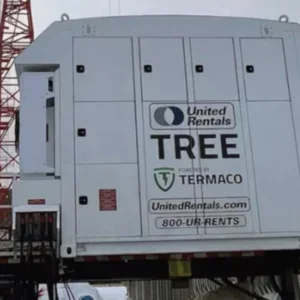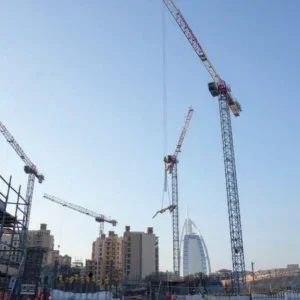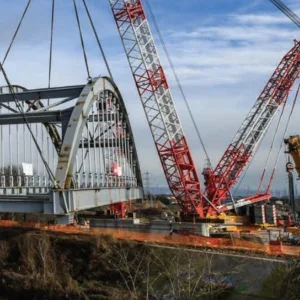Cranes are not designed to be “personnel lifts” (indeed, most crane manufacturers specifically state that their machines are for material handling), but it has long been recognised that cranes can be used to lift people. The only real issue is how the people involved in the lifting operation deal with the safety issues to ensure that the crane and operation will not injure or kill anyone.
I do not know the total number of workers injured or killed while being lifted by cranes, but I am sure it is too large. I am also sure that many of those injuries and deaths could have been avoided by applying common sense.
History of people lifting
A little history might help place the issue in a more understandable context. In the mid to late 1980s, lifting people with cranes was a common and relatively unregulated practice in all sectors – industrial, construction, and maritime – in the United States. The various government occupational safety and health advisory groups had held meetings and received industry input since 1974 (and continuing through 1985) to define the dangers of lifting people with cranes.
Additionally, the ASME B30 Consensus Standards dealing with cranes had discussed the hazards since the 1960s, issued several letters of interpretation on the lifting of people with mobile cranes, and had ultimately published its “best practice” in the February, 1983 edition of the ASME B30.5 Mobile Crane Standard. This publication was followed in November 1983 by a similar, but work type specific, standard from the National Safety Council entitled “A10.28 Construction and Demolition Suspended Work Platforms Standard”.
The trouble was that these efforts were too crane and work specific, and too limited in definition to prevent a workbasket containing 12 workers from falling in the summer of 1987. That single incident killed six, injured the other six, emotionally impacted on hundreds of co-workers, and initiated action in both regulation and standard development.
By August 1988, less than six months after the completion of the accident investigation, the federal Government published its first – and to date only – set of requirements for lifting personnel in its Construction Safety Regulations (29 CFR 1926.550(g)).
By the following June, the ASME B30 Crane Safety Standards Committee had established the B30.23 Committee whose charter was to develop a Personnel Lifting Standard that addressed all aspects of personnel lifting that could be applied to all types of cranes. This task took just over nine years, and culminated with the December 1998 publication of the ASME B30.23-1998, “Personnel Lifting Systems”.
This publication defined the requirements needed to lift people safely, and while there have been numerous local government and corporate interpretations and tailoring of the Standard, no deficiencies or inadequacies have shown up so far. Indeed, in my investigation of numerous personnel lifting accidents, I have not found a single issue surrounding the accidents that was not addressed in the B30.23 Standard.
The demands for personnel lifting are many and varied, but include the following: A crane should not be used to hoist employees on a personnel platform except when the erection, use, and dismantling of conventional means of reaching the work site would be more hazardous; or it is not possible because of structural design or work site conditions.
Crane equipment requirements
There are several requirements relating to crane equipment including:
• Load lines of regular type rope shall be capable of supporting at least seven times the maximum intended load.
• Load lines of rotation resistant type rope shall be capable of supporting at least ten times the maximum intended load.
• The crane may not have a live boom during the operation.
• Cranes with variable angle booms shall have a boom angle indicator.
• Cranes with telescoping booms shall have a device to indicate the boom’s extended length.
• Cranes shall have a positive acting anti-two-block device.
• Hooks on load blocks shall be of a type that can be closed and locked.
• Cranes shall have a system or device that provides controlled load lowering on the hoist drum. Free fall is prohibited.
Demands relating to platforms
Platforms and suspension systems must be designed by a qualified person. Other demands relating to this equipment include:
• The platform shall be capable of supporting its own weight and at least five times the maximum intended load.
• Platforms shall have permanent markings that indicate their weight and rated load capacity or maximum intended load.
• The suspension system shall be designed to minimise tipping.
• When a bridle is used, each leg shall be connected to a master link or shackle in such a manner to ensure that the load is evenly divided among the bridle legs.
• Bridles and associated rigging for attaching the platform to the crane shall be used only for the platform.
• Hooks on attachment assemblies shall be of a type that can be closed and locked.
• Wire rope, shackles, rings, master links, and other rigging hardware must be capable of supporting at least five times the maximum intended load applied to that component.
• Rotation-resistant rope shall be capable of supporting, without failure, at least 10 times the maximum intended load.
• Eyes in wire rope slings shall have thimbles.
• Platforms shall be equipped with a guardrail system.
• Platforms shall have a grab rail inside the entire perimeter.
• Platforms shall be enclosed from the toe board to mid-rail.
• Access gates shall not swing outward during hoisting.
• Access gates shall be equipped with a device to prevent accidental opening.
• Occupants shall be protected by overhead protection when they are exposed to falling objects.
• Headroom shall allow employees to stand upright.
• Edges exposed to contact shall be smooth in order to prevent injury from punctures or lacerations.
• All welding of the personnel platform shall be by a qualified welder.
Lifting workers with cranes will never be as safe as using equipment designed specifically for the purpose, but by applying common sense and following the published requirements, worker safety can be enhanced.






